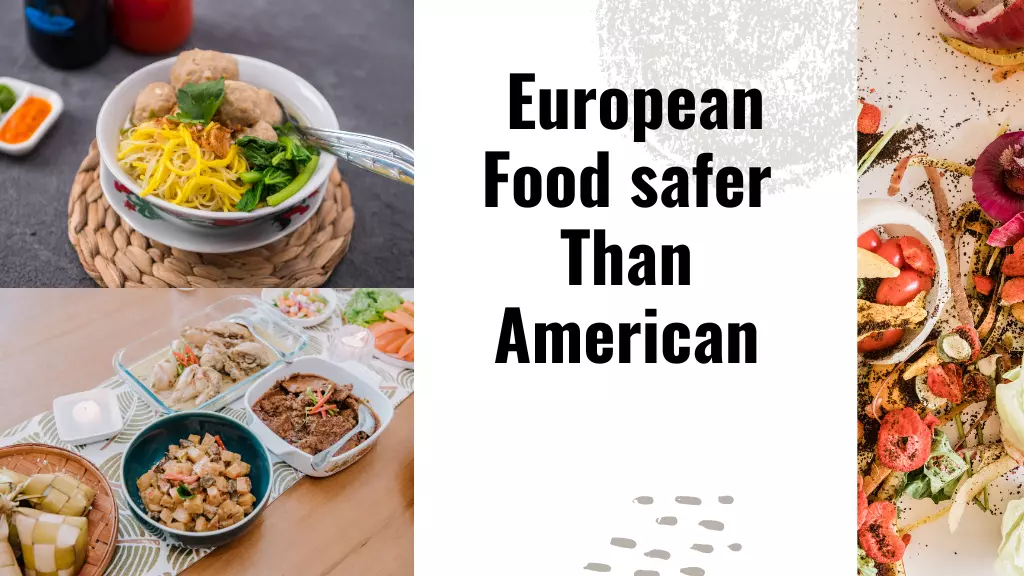Is European Food Healthier Than American? That’s an interesting question. There is no definitive answer to which cuisine is healthier, as it may depend on various factors such as the ingredients. is European food healthier than American the preparation methods and the individual preferences and dietary needs of the consumers.
However, some sources suggest that European food may have some advantages over American food in terms of health.
Why is European food healthier than American food?
As I mentioned before, there is no definitive answer to which cuisine is healthier, as it may depend on various factors. However, some possible reasons why European food may be healthier than American food are:
European food tends to have fewer preservatives, additives, and chemicals than American food,
which may be linked to their commitment to protecting human health and the environment.
European food labels show the amount of added sugars, trans fats, and allergens in the products, while American food labels do not.
it also uses a color-coded system to indicate the healthiness of the products, while American food labels use a numerical system that may be confusing or misleading.
European food regulations are more precautionary and protective than American food regulations, which may prevent potentially harmful substances from entering the food supply.
These are some of the possible reasons why European food may be healthier than American food.
However, it is important to remember that healthiness also depends on how much and how often one consumes certain foods, as well as other lifestyle factors such as physical activity, hydration, sleep, and stress management
Why is Europe’s food quality better?

There are several factors that may contribute to the better quality of food in Europe, such as:—
Local and seasonal production:
European food is often produced locally and seasonally, which means it is fresher, more flavorful, and more nutritious than food that is shipped from far away or grown out of season. Local and seasonal production also reduces the environmental impact of food transportation and storage.
Transparent and informative labeling:
European food labels are more transparent and informative than American food labels, which means consumers can make better choices about what they eat.
European food labels show the amount of added sugars, trans fats, allergens, and artificial ingredients in the products, as well as a color-coded system to indicate the healthiness of the products.
American food labels do not have these features and may be confusing or misleading.
Precautionary and protective regulations:
European food regulations are more precautionary and protective than American food regulations, which means they prevent potentially harmful substances from entering the food supply.
Europe also has stricter standards for animal welfare, environmental protection, and food safety than America.
Are people in Europe healthier than Americans?
There are different ways to measure the health of a population, such as life expectancy, mortality rates, disease burden, and health behaviors. Based on these indicators, it appears that people in Europe are generally healthier than Americans. Some examples are:–
Mortality rates:
Mortality rates are another way to compare the health of different populations. They show the number of deaths per 100,000 population from various causes, such as cardiovascular diseases, cancers, injuries, and infectious diseases.
In 2019, the U.S. had higher mortality rates than the average of comparable OECD countries (which include most European countries) for most of these causes. For example, the U.S. had a mortality rate of 164 per 100,000 population from cardiovascular diseases, while the OECD average was 106 per 100,000 population.
The display the number of fatalities per 100,000 people due to various conditions, including cancer, injuries, and infectious infections.
Disease burden:
Disease burden is a measure of the impact of diseases and injuries on a population’s health. It is expressed as disability-adjusted life years (DALYs), which are the sum of years of life lost due to premature death and years lived with disability due to illness or injury. In 2019, the U.S. had a higher disease burden than the average of comparable OECD countries, with 17,724 DALYs per 100,000 population, compared to 14,258 DALYs per 100,000 population for the OECD average. The main contributors to the disease burden in the U.S. were cardiovascular diseases, cancers, musculoskeletal disorders, and mental and substance use disorders.
Health behaviors:
Health behaviors are factors that influence the health of individuals and populations, such as smoking, alcohol consumption, physical activity, and obesity.
In general, people in Europe have healthier behaviors than Americans in some aspects, but not in others. For example, in 2019, the smoking prevalence among adults was lower in the U.S. than in the average of comparable OECD countries (14% vs. 18%), but the obesity prevalence was higher (37% vs. 24%). Similarly, in 2018, the alcohol consumption per capita was lower in the U.S. than in the average of comparable OECD countries (8.7 liters vs. 9 liters), but the physical activity level was also lower (53% vs. 64%).
Life expectancy:
Life expectancy at birth is a common measure of the overall health of a population. It reflects the mortality rates of different age groups and causes of death. In 2020, the average life expectancy at birth in Europe was 82.1 years, while in the U.S. it was 77.3 years. The gap between Europe and the U.S. has widened over time, partly due to the COVID-19 pandemic, which had a higher death toll in the U.S. than in most European countries.`
Merely a few instances of how the health of people in Europe and America might be studied. It is crucial to keep in mind that variances exist within every planet and nation, in addition to other elements that influence health outcomes, such as access to medical treatment, social determinants of health, environmental quality, and variation in genes.
Is European food healthier than safer than American?

Food safety is a complex and multifaceted issue that involves various aspects, such as food production, processing, distribution, labeling, inspection, testing, and regulation. Both Europe and America have food safety systems that aim to protect public health and prevent foodborne illnesses, but they differ in some of their approaches, standards, and practices. Some of the differences are:–
Food additives are substances that are added to food to enhance its flavor, color, texture, shelf life, or other properties.
Compared to America, Europe takes a more cautious and stringent approach to food additives by outlawing or restricting several ingredients such as sodium bromate, azodicarbonamide, artificial colors, flavors, sweeteners, chemicals, antibiotics, and pesticides.
These substances may have negative effects on health, such as increasing the risk of obesity, diabetes, cancer, and other chronic diseases.
Food labeling is the information that is provided on food packages or menus to inform consumers about the ingredients, nutritional value, origin, and safety of food products.
Europe requires the disclosure of added sugars, trans fats, allergies, artificial chemicals, genetically modified organisms (GMOs), and animal welfare requirements on food labels, making it more transparent and informative than American food labeling.
Europe also uses a color-coded system to indicate the healthiness of food products. America does not have these features and may have confusing or misleading food labels.
Europe has a more rigorous and frequent food inspection system than America, requiring all food establishments to be inspected at least once a year by independent authorities. Europe also has a farm-to-fork approach that covers the entire food supply chain from production to consumption. America has a less consistent and effective food inspection system that varies by state and federal agency and may miss some food hazards or outbreaks.
Do Europeans eat differently than Americans?
Yes, Europeans and Americans have different eating habits that reflect their cultural, historical, and geographical differences. Some of the main differences are:–
Cost of food: Americans pay less for processed foods, fast foods, and sodas than Europeans, but more for fruits, vegetables, and organic foods. This may affect the nutritional quality and diversity of their diets. Europeans have more access to affordable and healthy foods, which may explain why they consume more fruits and vegetables per capita than Americans.
Social meals: Europeans tend to eat more slowly and socially than Americans, who often eat on the go or alone. Europeans spend more time at the dinner table, enjoying their food and conversation with family or friends. Americans prefer convenience and speed, opting for fast food chains or takeout meals that can be eaten quickly. Europeans also have different meal patterns than Americans, such as eating a light breakfast, a large lunch, and a small dinner, while Americans tend to skip breakfast, eat a light lunch, and have a large dinner.
Soda: Americans consume more soda than any other country in the world, averaging about 44 gallons per person per year. Soda is widely available and cheap in America and is often consumed as a substitute for water or juice. Europeans drink much less soda than Americans, averaging about 14 gallons per person per year. Soda is more expensive and less accessible in Europe and is usually consumed as an occasional treat or a mixer for alcohol.
In fine, Here are just a few examples of how eating habits vary between Europeans and Americans. It is crucial to keep in mind that there are variations within every planet and nation, as well as personal preferences and choices that influence eating behaviors.
[hurrytimer id=”1299″]